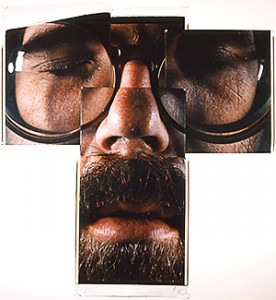 With this post I return, after a 10-month hiatus, to one of the two main stories that have preoccupied me here at Photocritic International since I inaugurated this blog in June 2009: the dismantling of the unique, world-famous Polaroid Collection, which I’ve tracked in more than two dozen posts (plus a number of Guest Posts by others) over the past two-and-a-half years.
With this post I return, after a 10-month hiatus, to one of the two main stories that have preoccupied me here at Photocritic International since I inaugurated this blog in June 2009: the dismantling of the unique, world-famous Polaroid Collection, which I’ve tracked in more than two dozen posts (plus a number of Guest Posts by others) over the past two-and-a-half years.
I come back to this complex situation with mixed feelings. On one hand, it pains me deeply to watch and report on the sad epic of the dismemberment of one of the greatest corporate collections of photography ever assembled: unique, invaluable, unduplicable, irreplaceable. For a variety of reasons sketched out in those earlier posts, we shall not see its like again. As a defining moment, its dispersal marks the end of an era.
At the same time, I feel a sense of relief that the narrative has entered its final chapter; those who’ve followed it along with me have manifested the dread that comes with prolonged waiting for the other shoe to drop. Moreover, there’s a narrative emergent here, rich and tangled, that calls for its dénouement. Now that’s upon us, at last.
Swann Song: Overture
At the request of court-appointed Trustee John R. Stoebner, charged with the task of recovering as much money as possible for the creditors of the collapsed Ponzi scheme created by the now-jailed Tom Petters, the Minnesota Bankruptcy Court has approved the transfer of the cluster of works known collectively known as the “Sotheby’s Assets” from Sotheby’s in New York City to Swann Auction Galleries in the same metropolis, for inclusion in a series of auctions, beginning with one coming up in April 2012.
Some backstory: At Stoebner’s request, the Minnesota Bankruptcy Court authorized an auction at Sotheby’s that skimmed off much of the cream of the collection — some 1260 images, roughly 8 percent of the total (around 16,000 pieces all told). That auction took place on June 21-22, 2010. Once the Sotheby’s event had concluded, the remainder of the Polaroid Collection went on sale, divided into three lots of varying sizes. The Trustee, again with the authorization of the Minnesota Bankruptcy Court, opened formal bidding on these three lots roughly one year ago, on January 3, 2011, indicating a closing date for bids of January 20, 2011.
To reiterate some details from my previous posts, the largest of these lots, referred to as the “Acquired Assets,” constituted the post-auction bulk of the remaining collection — some 10,000 pieces, then stored in Somerville, MA, and referred to variously in early court documents as the “Polaroid Fine Art Collection” or, alternatively, the “Artex Collection.” (My thanks to the estimable Sam A. Joyner, who has cleared up a small mystery to which I’ve referred several times in previous posts ― to wit, why the Minnesota Bankruptcy Court dubbed that chunk of the Polaroid Collection the “Artex Photographs.” Judge Sam writes, “Artex, Inc. is the name of the company Polaroid contracted with to warehouse the Somerville Collection.”) These pictures, plus some unspecified physical and legal assets, got cumulatively named the “Acquired Assets” in the more recent relevant notices and filings.
A mysterious entity called Perle Holdings Inc. bid $1,275,000.00 USD for the “Acquired Assets” and won it for that price in January 2011. Perle Holdings was what is known as a “stalking horse bidder,” somehow connected to a Luxembourg-based entity named Eastbridge N.V. (or Eastbridge B.V.). One Nathan Bruckner, on behalf of Perle Holdings (of which he is the sole shareholder), asserted in the affidavit accompanying its bid that it plans to create a “museum quality space . . . provid[ing] display and study opportunities with respect to the Acquired Assets for both general interest and scholarly audience, as well as a continued resource in photography, motion pictures, technology and books” . . . all of that inside 20 Exchange Place, a high-end residential/commercial structure that Eastbridge has partnered in renovating in the Wall Street district of New York. (The law firm of Herrick, Feinstein LLP represented Perle Holdings in that process.) Here’s my post on the 20 Exchange Place acquisition of the “Acquired Assets.”
 During that same period in January 2011, the second bulk sale of works from the collection took place — the acquisition of the”Swiss Photographs” by WestLicht-Peter Coeln GmbH, which offered $755,000.00 USD for those 4500 prints. They have now entered the collection of the WestLicht Schauplatz für Fotografie in Vienna, Austria. The Court’s name for this group of photographs derives from the fact that the works in question had resided for years at the Musée de l’Elysée in Lausanne, Switzerland, to whom the original, now-defunct Polaroid Corporation had promised them as a permanent loan. Since the Trustee received no higher bid, those prints went to Westlicht at the end of the short bidding period, January 20, 2011.
During that same period in January 2011, the second bulk sale of works from the collection took place — the acquisition of the”Swiss Photographs” by WestLicht-Peter Coeln GmbH, which offered $755,000.00 USD for those 4500 prints. They have now entered the collection of the WestLicht Schauplatz für Fotografie in Vienna, Austria. The Court’s name for this group of photographs derives from the fact that the works in question had resided for years at the Musée de l’Elysée in Lausanne, Switzerland, to whom the original, now-defunct Polaroid Corporation had promised them as a permanent loan. Since the Trustee received no higher bid, those prints went to Westlicht at the end of the short bidding period, January 20, 2011.
 The third and last cluster of works from the Polaroid Collection, and the only one still homeless, has been labelled the “Sotheby’s Assets” by the Court and its Trustee because they’ve been stored at that auction house for several years. The group includes:
The third and last cluster of works from the Polaroid Collection, and the only one still homeless, has been labelled the “Sotheby’s Assets” by the Court and its Trustee because they’ve been stored at that auction house for several years. The group includes:
(a) a number of pieces brought down to Sotheby’s from the bankrupt Polaroid Corporation’s storage facility in Somerville, MA, for consideration for inclusion in the spring 2010 auction, but eventually deselected for that purpose;
(b) the 11.2 per cent of the auction offerings that went unsold; and
(c) the ones withdrawn from the auction as a result of the campaign to stop the auction, led by several of the photographers whose works were placed on sale, represented by Joyner and several other attorneys.
The following lots ― with Sotheby’s estimated prices ― were withheld due to that campaign: Lot 26, Chuck Close: ‘5 C’ (Self Portrait)’ ($50,000–$70,000); Lot 145, Mary Ellen Mark: Selected New York Portraits ($8,000–$12,000); Lot 154, Andy Warhol: Martha Graham ($2,000–$3,000); Lot 170, Laurie Simmons: Selected Photographs from The Education Project ($4,000–$6,000); Lot 218, Joel Meyerowitz: Selected Images ($1,500–$2,500); Lot 223, Aaron Siskind: Selected Mexican Portraits ($1,500–$2,500); Lot 234, William Wegman: Selected Figure Studies, ($5,000–$7,000); Lot 445, Various Photographers: Selected Self-Portraits ($2,000–$3,000); and Lot 462, Danny Lyon: Selected Images ($5,000–$7,000). Other works that went on the block simply didn’t sell. (Click here for a PDF file of these unsold lots with full description thereof, and click here for a PDF with thumbnails and Sotheby’s original estimates. And click here for the final list of lots sold, with sale prices.)
The Trustee’s official minimum bid was $556.750.00 USD for the “Sotheby”s Assets,” presumably negotiable. Be that as it may, the Trustee received no acceptable bids during the formal bidding period — nor, apparently, in the year since. A few of the leftover works got sold individually to private buyers subsequent to the auction, but the bulk of this group remained in storage at Sotheby’s until its transfer to Swann.
Somewhat surprisingly, neither of the two institutional purchasers of the major chunks of the collection, as mentioned above, appear to have expressed interest in augmenting their new holdings by adding this batch thereto. I consider the Trustee’s asking price quite high for the less than 700 works included, given that the 4500 prints in the “Swiss Photographs” lot were priced at and sold for only $200K more, and the 10,000 works in the “Acquired Assets” lot were priced at and sold for $1,275,000.00. So I have to assume that the Trustee’s minimum bid and refusal to negotiate deterred them, since the “Sotheby’s Assets” does contain some choice items that I’d think worthy of an institutional collection, if reasonably priced.
 Since Sotheby’s had either declined to auction the works in this final lot or else tried and failed to sell them, and since no buyer has come forward with interest in the lot, the Trustee will now exercise the only option left, that of disposing of them via further auctions at a second-tier house. Swann has a long and respectable history of selling photographs and photography-related materials, so it’s the logical choice for this task. The court orders delegating these concluding sales to Swann authorize that house to sell them at “one or more auctions it plans to conduct during the next one year,” with the first of those coming up, as noted, on April 12. Nothing in the orders obligates Swann to conduct a second dedicated “Polaroid Collection” auction, as did Sotheby’s. Furthermore, Swann is empowered to vend these last fragments of the Polaroid Collection “through private sales” as well. (Click here for a downloadable PDF file of those orders.)
Since Sotheby’s had either declined to auction the works in this final lot or else tried and failed to sell them, and since no buyer has come forward with interest in the lot, the Trustee will now exercise the only option left, that of disposing of them via further auctions at a second-tier house. Swann has a long and respectable history of selling photographs and photography-related materials, so it’s the logical choice for this task. The court orders delegating these concluding sales to Swann authorize that house to sell them at “one or more auctions it plans to conduct during the next one year,” with the first of those coming up, as noted, on April 12. Nothing in the orders obligates Swann to conduct a second dedicated “Polaroid Collection” auction, as did Sotheby’s. Furthermore, Swann is empowered to vend these last fragments of the Polaroid Collection “through private sales” as well. (Click here for a downloadable PDF file of those orders.)
The results will give some indication of how realistic was Trustee John Stoebner’s estimate of the value of the aggregate group. The Trustee has elected not to make publicly available any checklist of the supposedly 685 items contained in the “Sotheby’s Assets,” making it difficult to discuss this group of works as an aggregate and in its separate parts. Presumably Swann will issue catalogs prior to the auction(s) involving this material over the next year, and perhaps will make a comprehensive catalog of the “Sotheby’s Assets” available to prospective buyers.
•
For an index of links to all previous posts related to this story, click here.
•
This post supported by a donation from photographer Philip Trager.










Dear Allan,
Thank you for the update. I would love someday to visit my poor little prints, in the highly unlikely event that they are ever displayed at 20 Exchange Place. I would even make an appointment to view them in the no doubt professionally appointed space the new owners of the collection are planning to accommodate a scholarly “audience.”
I am one of the lucky ones. The two photographs Polaroid obtained from me in 1989 are silver prints made (by me) that year from original (1985 and 1989) Polaroid Type 55 negatives. Duplicate (or close to duplicate) prints that I made at the same time exist, and those negatives are in a box in the next room. I still feel somewhat robbed, of course, but in fact I feel far worse for anyone whose original Polacolor, SX-70, or 8×10 (or any other one-of-a-kind) prints are in that group of images.
I certainly am happy that Taschen produced The Polaroid Book well before the film was discontinued and the Petters debacle occurred (followed by the Minnesota bankruptcy debacle).
I would be very interested in seeing a checklist of that collection, if one is ever produced, if for no other reason than to confirm that those prints of mine are present.
Anyway, thank you for your continuing coverage of the situation.
Lou Barranti
Seems to me that between the cataloguing done by the several institutions that housed portions of the collection (the original Polaroid site in Somerville, the Musée de l’Elysée in Lausanne), the two main purchasers of the bulk of the collection (20 Exchange Place, Westlicht) and the several auction houses that will have catalogued them in preparation for sales, it should be possible to create an approximate virtual version of the Polaroid Collection. I’ll gladly publish such a database online at one of my websites, the Photography Criticism CyberArchive, with free access, if someone else undertakes the task of pulling it together.
Aah the ways of the legal system. Since writing a letter to the Polaroid trustees, at your suggestion, in 2009, I have been receiving non-stop mailings from the Minnesota Bankruptcy Court. Can’t help wondering at the cost of preparing, copying and posting this tonnage of paper legalese.
Best, Joan
Apparently, everyone who registered an objection to the sale with the Court got added to the mailing list. That appears to be a legal requirement.
Irksome though it may be to get this stream of mail, better that all this happens on the record rather than off, by my lights, and that documentation gets distributed to all interested parties.
Such a paper trail contributes to subsequent research, of course. Hope you’re saving your mailings for the VSW files, where scholars of the future will make good use of them. I’m saving mine for eventual donation to an archive, and advise the other recipients to do likewise.